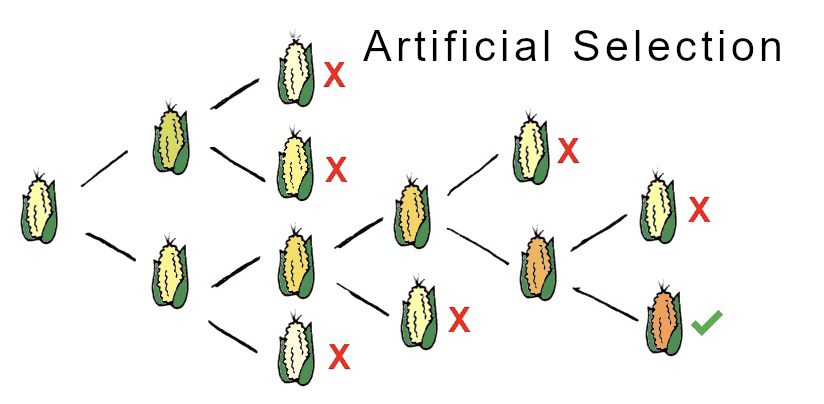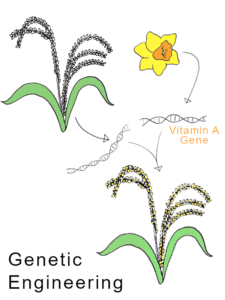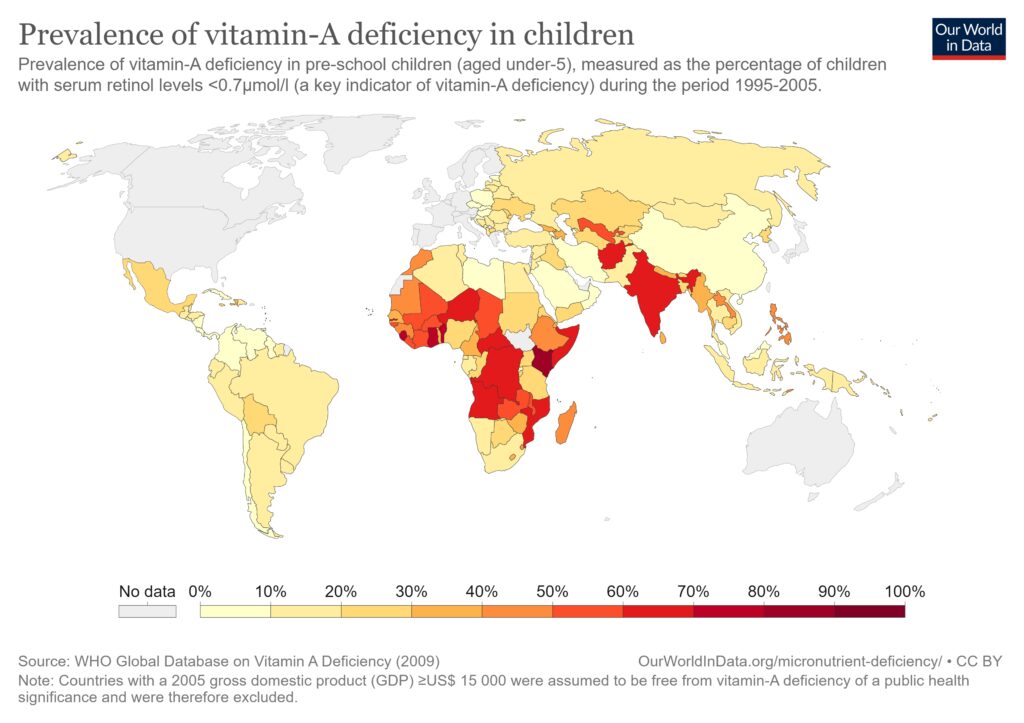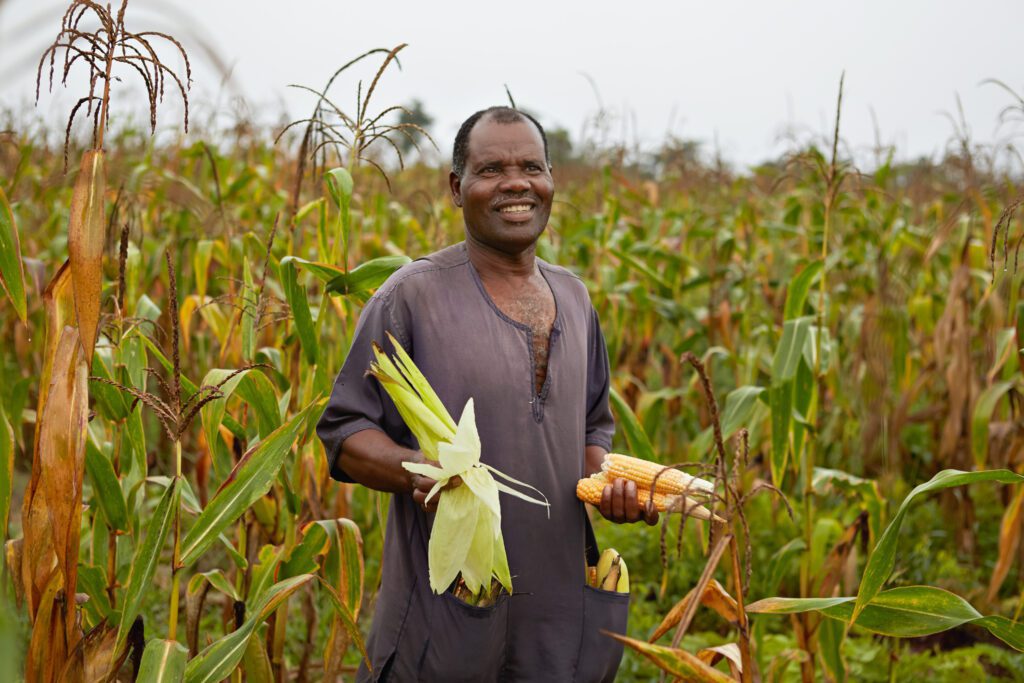
Better from the Beginning
How Biofortification is Improving Nutrition Across the Globe
Food nourishes us and gives us the energy we need to survive as living beings. Most of the time, when people think of food they think of carbs, fats, and protein: the basic building blocks of nutrition. However, another critical part of a healthy diet is micronutrients. Vitamins and minerals, like iron or calcium, are micronutrients that have essential functions in the body that people cannot live without. These elements are often not present in significant quantities in staple crops, like wheat or corn, which is why a person needs a diverse diet to make sure that they get the proper amount of vitamins and minerals. Across the globe, however, many populations rely almost exclusively on a single staple crop for their calories. Without sufficient dietary diversity to supplement this crop, this often leads to a lack of micronutrients in their diets. Biofortification is an agricultural strategy that attempts to fix this problem by increasing the micronutrient content of staple crops (aka fortifying them) through biological methods such as plant breeding. This in turn creates nutritionally enhanced crop varieties such as iron-rich wheat, or vitamin A-rich corn. These nutritionally enhanced crops can then be shared with micronutrient-deficient populations, who can grow them year after year to supply themselves with the nutrients they need to lead healthy lives on an ongoing basis. In the late 1990’s and early 2000’s, people like Professor Torbert began working on the development of nutritionally enhanced crops. Now, after decades of hard work and dedication, these crops have been introduced across the globe and are helping to improve the nutritional status of millions of individuals!
What is Biofortification?
Nutritionally enhanced crops (also known as biofortified crops) are staple crops, like corn or sweet potatoes, that have been bred to contain increased levels of specific micronutrients like iron or vitamin A. Macronutrients and micronutrients are both critical in a person’s diet for good health. Macronutrients include proteins, fats, and carbohydrates, which are the largest essential components of food, and typically the first thing that comes to mind when people think about nutrition. However, an often less-talked about part of nutrition are micronutrients, consisting of minerals and vitamins like zinc, iron, and vitamin A. These nutrients play a key role in a person’s immune system, eyesight, brain development, and other critical bodily functions. Since both macronutrients and micronutrients are integral for health, even if a person is consuming enough calories (not starving), they can still suffer from severe malnutrition due to a lack of micronutrients. This is called “hidden hunger,” and it affects more than 30% of the global population (Garg et al., 2018). With massive implications on the health and productivity of affected populations, hidden hunger is one of the most pressing issues affecting low-income countries today. Traditional fortification methods (adding nutrients to processed foods, e.g. adding iodine to salt, calcium to orange juice, vitamin D to milk) and supplementation help address these issues, however, they alone have proven to be insufficient for many populations that don’t participate in a highly industrialized food system (like those that exist in the United States and Europe). Therefore, such a large and complex issue requires an innovative and holistic solution, which is precisely what nutritionally enhanced crops have been designed to be.
How are Crops Nutritionally Enhanced?
Nutritionally enhanced crops can be created through agronomic practices, breeding (also called artificial selection), or genetic engineering. Regardless of the method, all three aim to deliver a crop with higher concentrations of micronutrients in the edible part of the plant. Since each crop has its own biological constraints and each population has unique agricultural practices, dietary preferences, and nutritional needs, the use of different methods to nutritionally enhance crops helps ensure the maximum number of people can benefit from this innovative solution.

Agronomy
Perhaps the simplest way of nutritionally enhancing a crop is with agronomy. The agronomic method changes the environment of the plant, which creates a higher micronutrient concentration in the edible part of the plant (Garg et al., 2018). The easiest agronomic method to visualize is probably fertilization, which can be seen in the image to the right. An iron-rich fertilizer can be used to fertilize a wheat plant. This plant then absorbs the iron, and stores it in the edible part of the plant (the grain), which can then be eaten (Garg et al., 2018). While this method is fairly straightforward and cheap, it requires a fortification process every year. This means that agronomic biofortification projects need constant and stable funding for them to continue, which isn’t always possible in isolated and rural communities, where most micronutrient-deficient populations live (Garg et al., 2018). Additionally, agronomic fortification isn’t possible with all micronutrients, with it being limited mostly to minerals like zinc and iron (Garg et al., 2018).
Plant Breeding
The oldest method of biofortification is plant breeding, also known as artificial selection (which is contrast to natural selection, or selection that occurs in nature during the evolutionary process without “artificial” human intervention). It is thought to have first been used by people in southwest Asia almost 10,000 years ago and is still used today (Rangel, 2016)! Fast forward and this ancient practice is still the primary method used to develop new crop varieties today and is the same method used by Professor Torbert to develop Orange Corn. Plant breeding in this context is essentially only growing plants with seeds from plants with higher micronutrient concentrations.

To better explain, let’s say that in corn, the deeper orange the kernel is, the more vitamin A it contains (this is not always true, but helpful for understanding). It therefore makes sense that if you only plant the most orange kernels (“selecting”), over time, your corn will become a deeper orange, which you can see in the image to the left. You can follow the same process with micronutrient concentration. By doing this over generations, the micronutrient concentration in the crop increases, until you have a plant variety that is nutritionally enhanced enough to make an impact on the health of those who consume it. For this process to be possible, a plant needs to already have traces of the micronutrient you aim to fortify the plant with at the beginning. Or in other words, you can’t select for a trait that isn’t present. So for example, unlike corn which has many varieties with yellow kernels that can be selected for darker and darker color, you can’t select for yellow or orange rice kernels because all rice kernels are naturally white.

Genetic Engineering
While traditional plant breeding is an extremely powerful tool, it does have its limitations. This is why some scientists have turned to a more recently developed method to create nutritionally enhanced crop varieties that wouldn’t be possible with selection alone. Genetic engineering (also known as genetic modification) makes it possible to introduce new qualities to a plant that weren’t originally there, for example making rice yellow. Biology has a very simple rule: DNA acts as the instructions telling an organism what to do. In the rice example, if we change the instructions to tell the rice to make vitamin A, we can have vitamin A-rich rice. But how do we create these instructions, also known as genes, in the first place? Writing genes from scratch is very complicated, but luckily they already exist in nature. The common wild daffodil makes vitamin A naturally, which is what gives it its beautiful yellow color. By copying the vitamin A instructions from a source like the wild daffodil, and pasting it into rice, we can tell rice to produce its own vitamin A, making a nutritionally enhanced rice variety. This rice variety is more commonly known as golden rice, named after the yellow color from the daffodil gene (Golden Rice Humanitarian Board). Compared with traditional plant breeding, genetic engineering can more precisely target a single trait, but consequently, it is also far less reliable (Garg et al., 2018). This can be seen in the many attempts it took to create a successful golden rice variety. With the further development and use of genetic engineering technologies, the method is becoming significantly more reliable, however, crops developed with these technologies still face significant hurdles in their implementation since many populations around the globe are hesitant to adopt or outright reject the use of genetically modified organisms (GMOs).
Getting More Micronutrients to the People that Need Them
One of the largest hurdles to addressing micronutrient deficiencies (hidden hunger) is that affected populations typically have limited money, limited access to healthcare, and often aren’t aware of the importance of specific micronutrients (Garg et al., 2018). Government funded commercial fortification and supplementation can help, however it is hard to make sure these products reach the target populations, who often live in rural isolated areas. At the same time, many people around the globe rely on one staple crop as the source of most of their calories. In southeast Asia, for example, many people eat almost exclusively white rice, and in Sub-saharan Africa, many people eat mostly white corn (Ekpa et al., 2018 & Charles, 2008). While these crops are able to provide enough calories for these populations to live off of, they lack the micronutrients necessary for healthy, immune systems, brain development and other key bodily functions. As such, these populations could be significantly helped by partially or fully replacing their staple crops with nutritionally enhanced crop varieties. Furthermore, once the nutrient-enhanced crop is implemented into a part of a country’s agricultural system, that crop becomes a constant source of micronutrients for the population, making it a one-time investment with almost unending returns (Garg et al., 2018 & Khusch et al., 2012).

Health Benefits of Fortification
While the most obvious benefit of nutritionally enhanced crops is improving the health of individuals, when viewed on a population-wide level, these improvements can have much broader implications. In a study, vitamin A deficient people were given vitamin A supplements in order to see the effects it had on their health. It was found that vitamin A fortification reduced the mortality of children 6 months to 5 years old by 23%-35%. Vitamin A was shown to protect children from death due to diarrhea, malaria, and measles, and this study did not even factor in the additional role vitamin A played in preventing blindness (Ezzati et al., 2004). Another study performed on teenagers from India studied the effects of eating high iron pearl millet on their brain function and cognition. After eating a diet of nutritionally enhanced pearl millet, the teenagers had significantly higher iron levels, brain function, and cognition. In addition to preventing the effects of iron deficient anemia, sufficient iron was shown to improve attention and memory (Wenger et. al., 2022). Both of these cases show the clear benefits at the level of the individual, however, these studies also show the enormous potential change biofortification programs can have at a population level. For developing countries, a population not hindered by significant child mortality can be more productive, and therefore have more opportunities for sustainable and stable growth. Similarly, populations without significant obstacles in terms of cognitive and brain development have more potential for innovation, and therefore similar growth. At a macro level, nutritionally enhanced crops can allow populations hindered by hidden hunger to reach their full potential.
HarvestPlus and Professor Torbert
A hugely influential organization helping to successfully implement nutritionally enhanced crops is HarvestPlus, a part of the Consultative Group for International Agricultural Research. HarvestPlus works with local farmers and businesses in middle and low income countries to help them incorporate nutritionally enhanced crops into their food systems. In empowering people to help their local communities, HarvestPlus hopes to foster systems that continuously provide people with necessary micronutrients completely independent of outside help. HarvestPlus gives farmers access to nutrient enhanced seeds, which can replenish themselves after every harvest. This initiative also hopes to inspire people to develop their own businesses and self-sustaining systems around nutritionally enhanced crops and food products.

Professor Torbert is one of the founding contributors of the HarvestPlus project, helping to develop vitamin A rich corn varieties for people with vitamin A deficiencies. To make a positive impact on the world, Professor Torbert hand selected varieties of corn with higher levels of carotenoids. He and his colleagues also made key scientific discoveries that enabled the selection of corn varieties with unprecedented levels of vitamin A. These varieties and knowledge were then used by HarvestPlus to develop varieties of vitamn A rich corn adapted to specific growing conditions around the globe, so they could be used by vitamin A deficient populations. Together, they were able to develop and distribute corn varieties with high levels of beta-carotene, a vitamin A precursor, to help alleviate vitamin A deficiencies in Sub-Saharan Africa. Today, communities in over ten African countries are harvesting and eating Orange Corn, where the hard work of local farmers, HarvestPlus, and Professor Torbert all help to reduce the negative outcomes of vitamin A deficiencies.
Hidden Hunger in America
In America, hidden hunger is not as significant of a problem, however, there are still nutrients that the average population may be lacking. Two antioxidant carotenoids, lutein and zeaxanthin, have been found to play an important role in brain and eye health (Johnson, 2014). It has also been found that many Americans have a lower than recommended daily intake of lutein and zeaxanthin, which could negatively impact their brain health and eyesight as they age (Johnson, 2014). The Orange Corn variety Professor Torbert originally developed for HarvestPlus is rich in vitamin A to help supply this vital nutrient to populations where it is needed, primarily in Sub-Saharan Africa. Since vitamin A deficiencies are rare in the US, the Orange Corn variety available here has been selected for increased levels of lutein and zeaxanthin, both critical for maintaining healthy eye function, which is much more of a concern for most Americans than vitamin A deficiency. Since the body cannot produce carotenoids, we must get them from our food, making Orange Corn an excellent option to deliver that additional nutritional punch to your daily diet!
Biofortification and Orange Corn
Hidden hunger, or micronutrient deficiency, is a huge problem globally, and biofortification can be utilized to help combat it. Today, biofortification is helping millions of people across the globe live healthier lives by enhancing the levels of micronutrients in the foods they already eat. Crops can be nutritionally enhanced with agronomy, artificial selection, or genetic engineering, with different approaches being more or less suitable depending on the crop and nutrient being targeted for enhancement. While Orange Corn started out as a vitamin A enhanced crop for HarvestPlus, Professor Torbert has worked hard to hand-select other varieties specifically tailored to the needs of the US population, which has low intakes of the health promoting antioxidant carotenoids lutein and zeaxanthin in their diets. So, when you choose Professor Torbert’s Orange Corn, you aren’t just making a great choice for yourself, you’re also participating in a global movement that seeks to eradicate the ravages of hidden hunger. Or as we like to say, “Tastes Good, Does Good!”
To learn more about biofortification check out these additional resources:
Charles, D. (2008, January 20). New yellow corn could boost vitamin A, save sight. NPR. Retrieved August 8, 2022.
Ekpa, O., Palacios-Rojas, N., Kruseman, G., Fogliano, V., & Linnemann, A. R. (2018, April 10). Sub-Saharan African maize-based foods: Technological perspectives to increase the food and nutrition security impacts of maize breeding programmes. Science Direct. Retrieved August 8, 2022.
Ezzati, M., Lopez, A. D., Rodgers, A., & Murray, C. (2004). Comparative quantification of Health Risks: Sexual and reproductive health. World Health Organization. Retrieved August 8, 2022.
Garg, M., Sharma, N., Sharma, S., Kapoor, P., Kumar, A., Chunduri, V., & Arora, P. (2018, February 14). Biofortified crops generated by breeding, agronomy, and transgenic approaches are improving lives of millions of people around the world. Frontiers. Retrieved August 8, 2022.
Golden Rice Humanitarian Board. (n.d.). The Science of Golden Rice. Golden Rice Project. Retrieved August 8, 2022.
Hannah Ritchie and Max Roser (2017) – “Micronutrient Deficiency“. Published online at OurWorldInData.org.
Johnson, E. J. (2014). Role of Lutein and zeaxanthin in visual and cognitive function throughout the lifespan. Nutrition Reviews, 72(9), 605–612.
Khush, G. S., Lee, S., Cho, J.-I., & Jeon, J.-S. (2012). Biofortification of crops for reducing malnutrition. Plant Biotechnology Reports, 6(3), 195–202.
Rangel, G. (2016, October 23). From Corgis to corn: A brief look at the long history of GMO Technology. Science in the News. Retrieved August 8, 2022.
Wenger, M. J., Murray Kolb, L. E., Scott, S. P., Boy, E., & Haas, J. D. (2022). Modeling relationships between iron status, behavior, and Brain Electrophysiology: Evidence from a randomized study involving a biofortified grain in Indian adolescents. BMC Public Health, 22(1).
World Health Organization. (1970, January 1). Global prevalence of vitamin A deficiency in populations at risk 1995-2005 : Who global database on vitamin A deficiency. World Health Organization. Retrieved August 8, 2022.
